How Many Watts Does an RV Air Conditioner Use?
An RV air conditioner (AC) is a critical appliance for maintaining comfort during warm weather, especially when traveling in remote areas. Understanding the amount of energy your RV AC uses is essential for efficient power management, ensuring you have adequate power sources like generators or solar systems. The wattage consumption of an RV AC unit depends on various factors, including its size, model, and usage conditions. In this section, we’ll explore how to calculate the power consumption of your RV air conditioner, including key terminology such as wattage and BTUs.
Understanding RV AC Wattages and BTUs
To accurately assess how many watts your RV air conditioner consumes, it’s essential to understand the relationship between watts and BTUs (British Thermal Units). BTUs measure the amount of heat an air conditioner can remove from a space per hour, while wattage indicates the electrical power consumption of the unit. The higher the BTUs, the more powerful the AC and the greater its energy requirements. For example, a 13,500 BTU air conditioner typically uses between 1,200 to 1,500 watts when running.
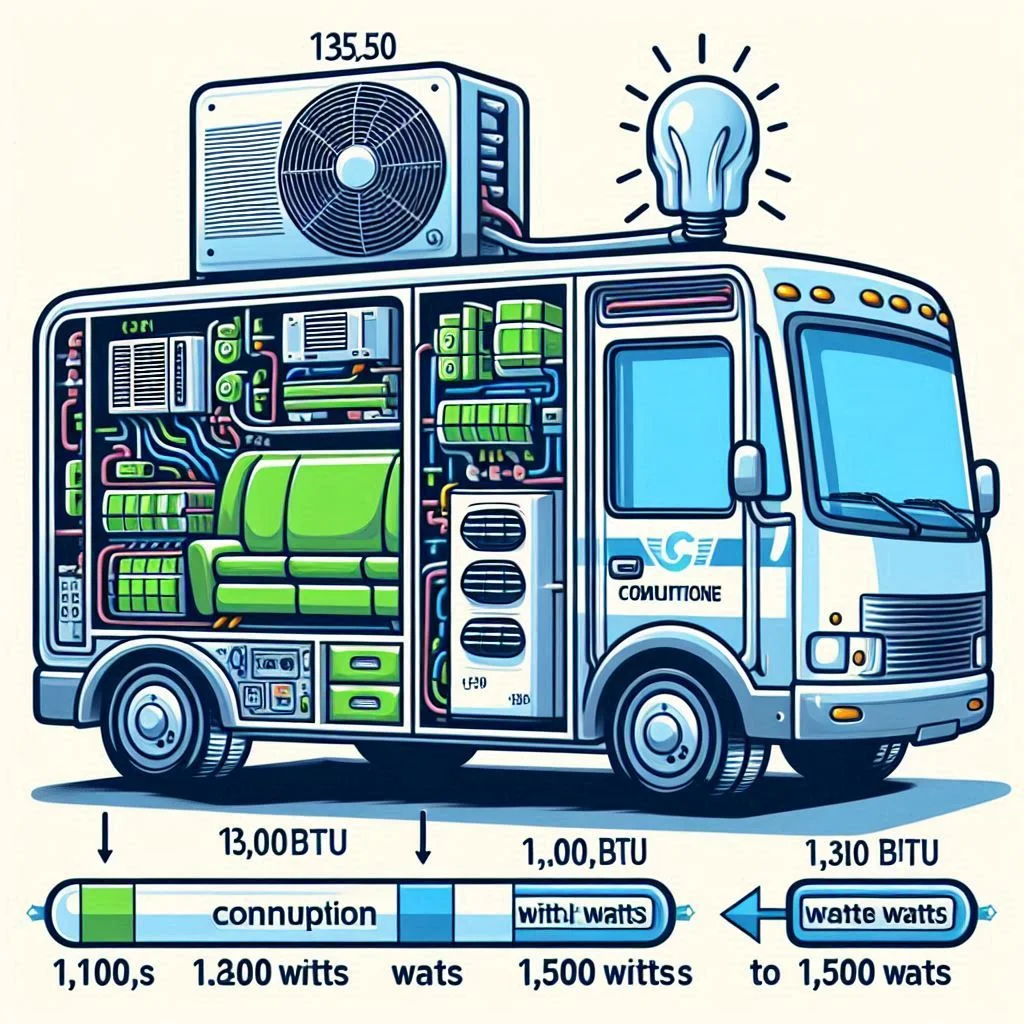
Starting Wattage vs. Running Wattage
When operating an RV air conditioner, there are two main types of wattage to consider: starting wattage and running wattage. Starting wattage is the initial surge of power needed to start the air conditioner. This surge can be 2-3 times higher than the running wattage, which is the continuous amount of power the unit uses to operate once it’s running.
For example, a 13,500 BTU air conditioner may require 3,000 to 3,500 watts of starting power, but only need 1,200 to 1,500 watts of running power. It’s crucial to account for the starting wattage when selecting a generator, as it needs to supply enough power to handle the surge.
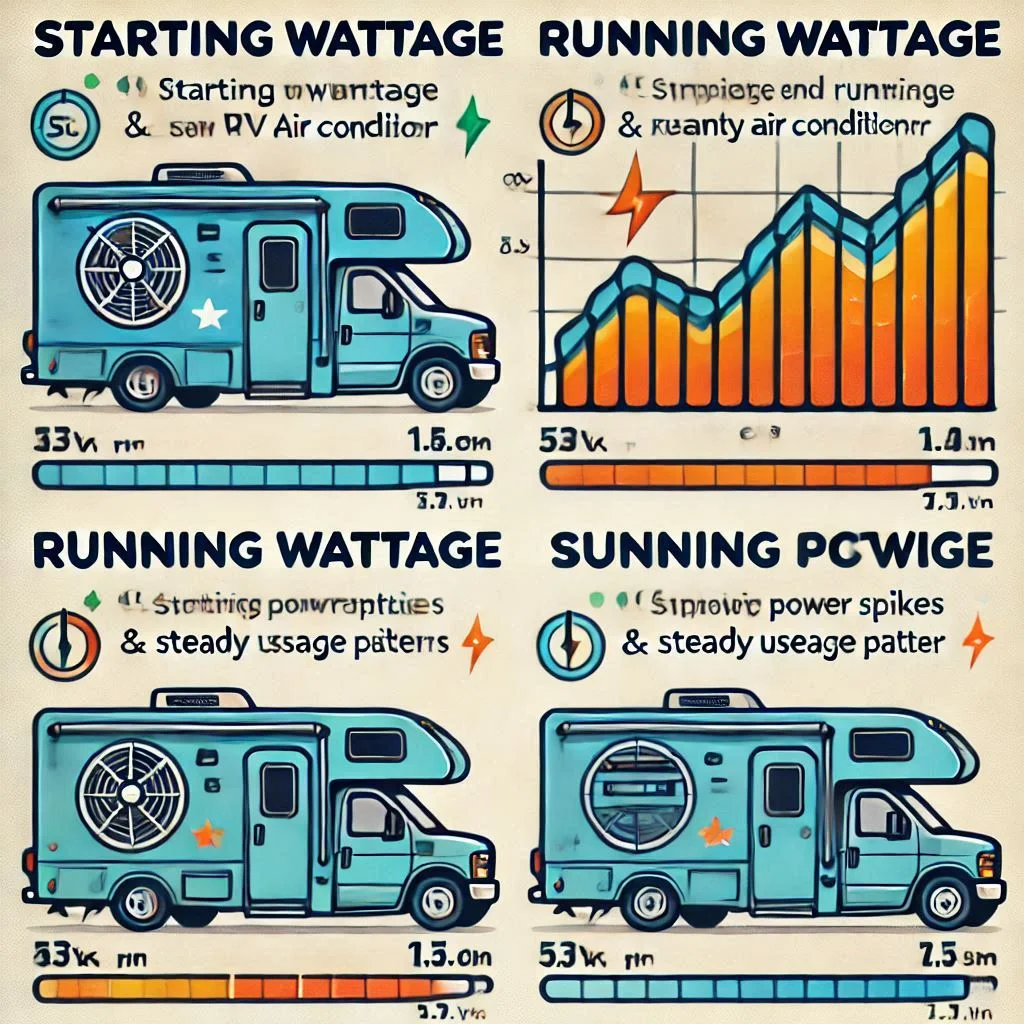
Common RV AC Unit Sizes and Their Wattage
The size of the air conditioner plays a significant role in its power consumption. RV AC units typically come in sizes ranging from 8,000 BTU to 15,000 BTU, with larger units requiring more energy. Here are some common RV AC sizes and their corresponding wattage:
- 8,000 BTU AC: Uses around 900-1,000 watts of running power.
- 13,500 BTU AC: Requires about 1,200-1,500 watts during operation.
- 15,000 BTU AC: Can use 1,500-2,000 watts when running.
Larger RVs with multiple air conditioners may require more watts to keep the interior cool, while smaller models or campers might use less power. It’s important to choose the right size unit for your RV to avoid overloading your generator or power system.
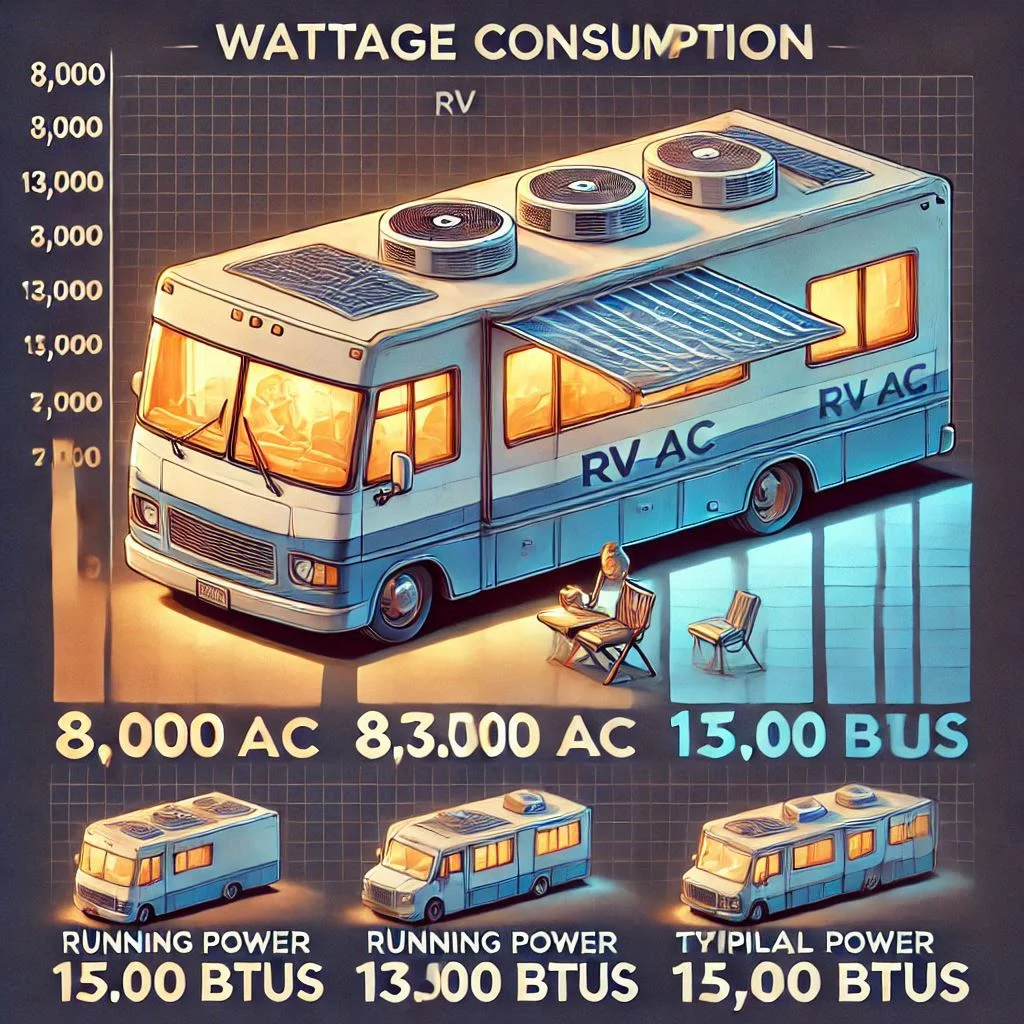
Factors Affecting RV Air Conditioner Wattage
When determining the wattage consumption of an RV air conditioner, several factors come into play. These factors can influence the amount of energy your AC unit uses to cool the space efficiently. Understanding how these variables impact your AC’s performance is essential for optimizing your energy consumption, especially when using off-grid power sources like generators or solar systems. In this section, we will explore the key factors that affect the wattage consumption of your RV’s air conditioning system.
Size of the RV
The size of your RV plays a significant role in how much wattage the air conditioner uses. Larger RVs with more living space require more energy to cool effectively, while smaller RVs can typically maintain a comfortable temperature with a lower wattage unit. For example, a 13,500 BTU air conditioner might be sufficient for a small RV or travel trailer, while a larger motorhome or fifth wheel could require a 15,000 BTU or higher unit.
The larger the RV, the more cooling power is needed, and thus, the higher the wattage consumption. The size also influences the number of air conditioners you might need to install to ensure proper cooling. Many larger RVs have multiple AC units, which collectively increase wattage demand.
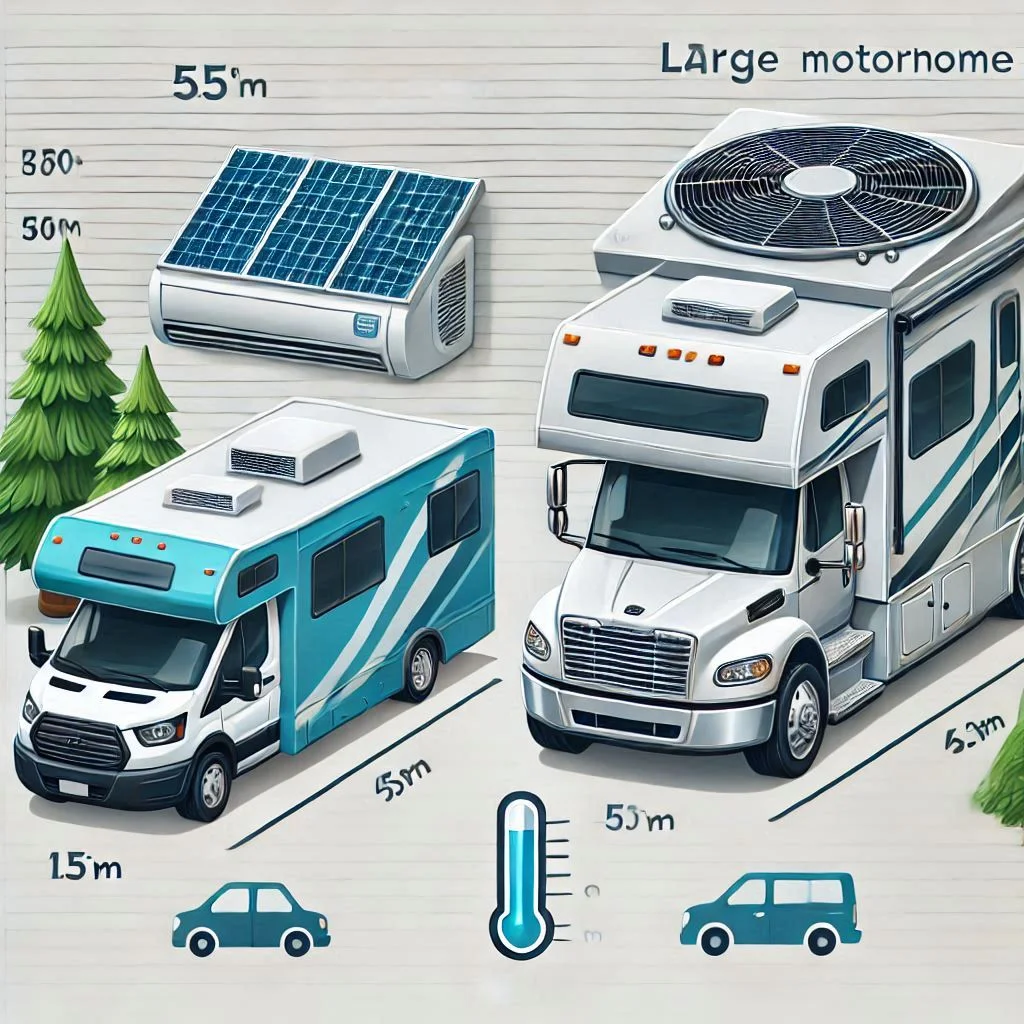
Ambient Temperature and Humidity
Ambient temperature and humidity levels significantly affect how hard your RV’s air conditioner has to work to cool the interior. On hotter days or in high-humidity climates, the air conditioner will need to consume more wattage to maintain a comfortable indoor temperature. In extremely hot environments, an air conditioner may run at full capacity for longer periods, increasing its overall energy consumption.
Humidity plays a role as well. Higher humidity means the AC needs to work harder to dehumidify the air before cooling it. This extra load increases the wattage usage. Conversely, on cooler days or in low-humidity environments, the AC’s wattage consumption will be lower, as it doesn’t have to run as frequently or at full power.
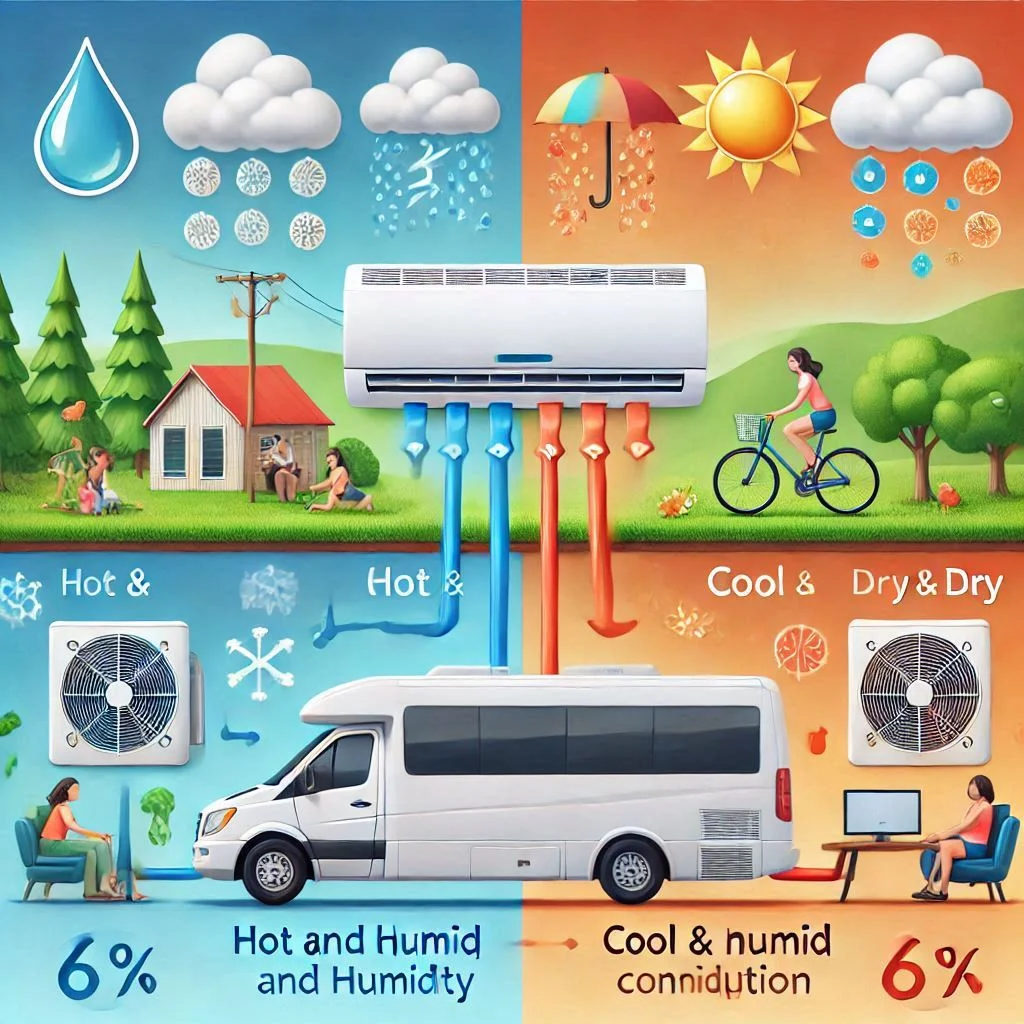
Insulation Quality in the RV
The insulation quality of your RV is one of the most critical factors in determining how much wattage your air conditioner will use. Well-insulated RVs are better at retaining cool air, reducing the workload on the AC and, in turn, the wattage consumption. Poor insulation, on the other hand, allows cool air to escape, forcing the air conditioner to run longer and consume more energy to maintain the desired indoor temperature.
Upgrading insulation, especially around windows, doors, and the roof, can improve cooling efficiency and reduce the strain on the air conditioner. In the long run, investing in good insulation helps lower energy costs by minimizing the amount of power your AC uses.
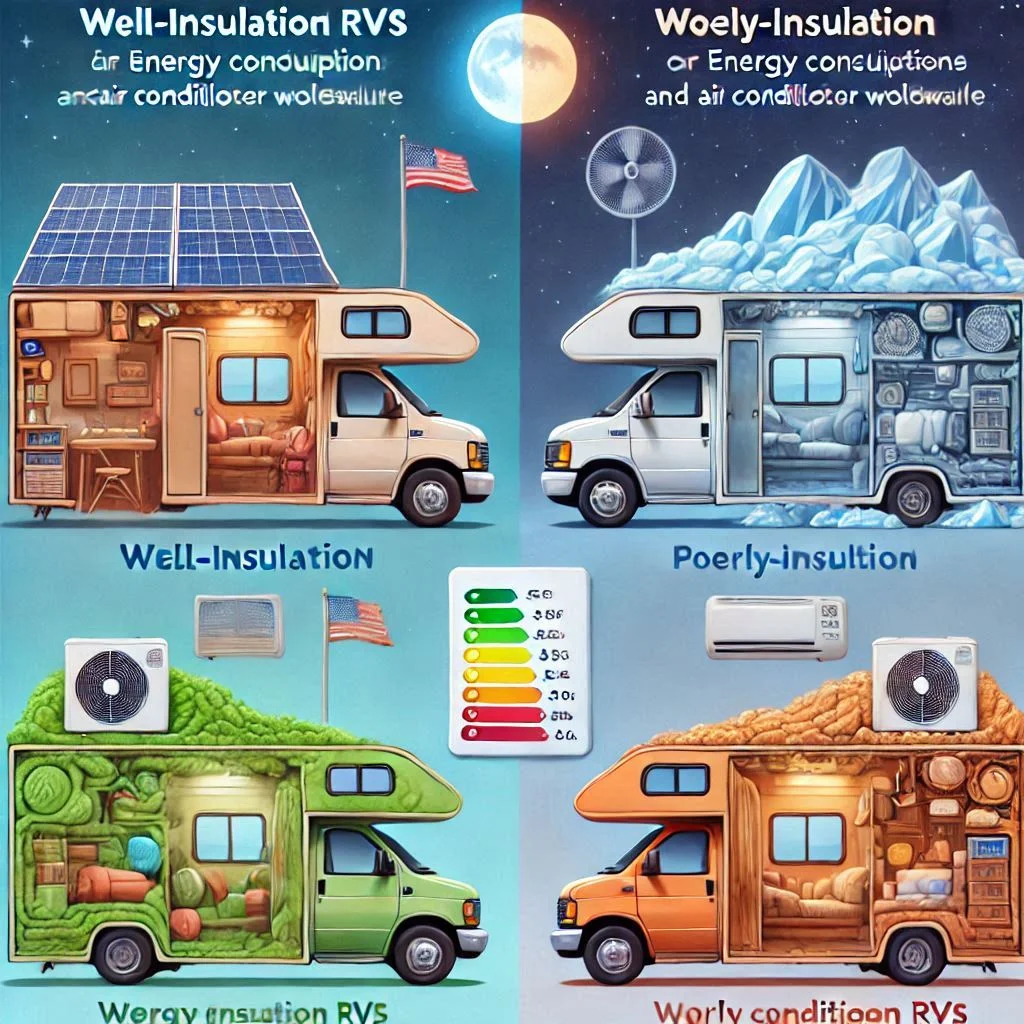
RV Layout and Power Source
The layout of your RV and the type of power source available can also impact how much wattage your air conditioner uses. If your RV has multiple rooms or compartments, your AC unit may need to work harder to cool these areas evenly, leading to higher wattage consumption. Additionally, the location of vents and airflow design plays a role in cooling efficiency. Poor airflow may cause the air conditioner to operate less efficiently, increasing energy use.
The power source—whether you’re using a generator, solar power, or shore power—also influences energy consumption. For example, some RVs are designed to be more energy-efficient with solar systems, while others rely on gas-powered generators that may consume more energy to run the AC unit. The type and quality of the power source directly impact the performance of the air conditioner and its energy usage.
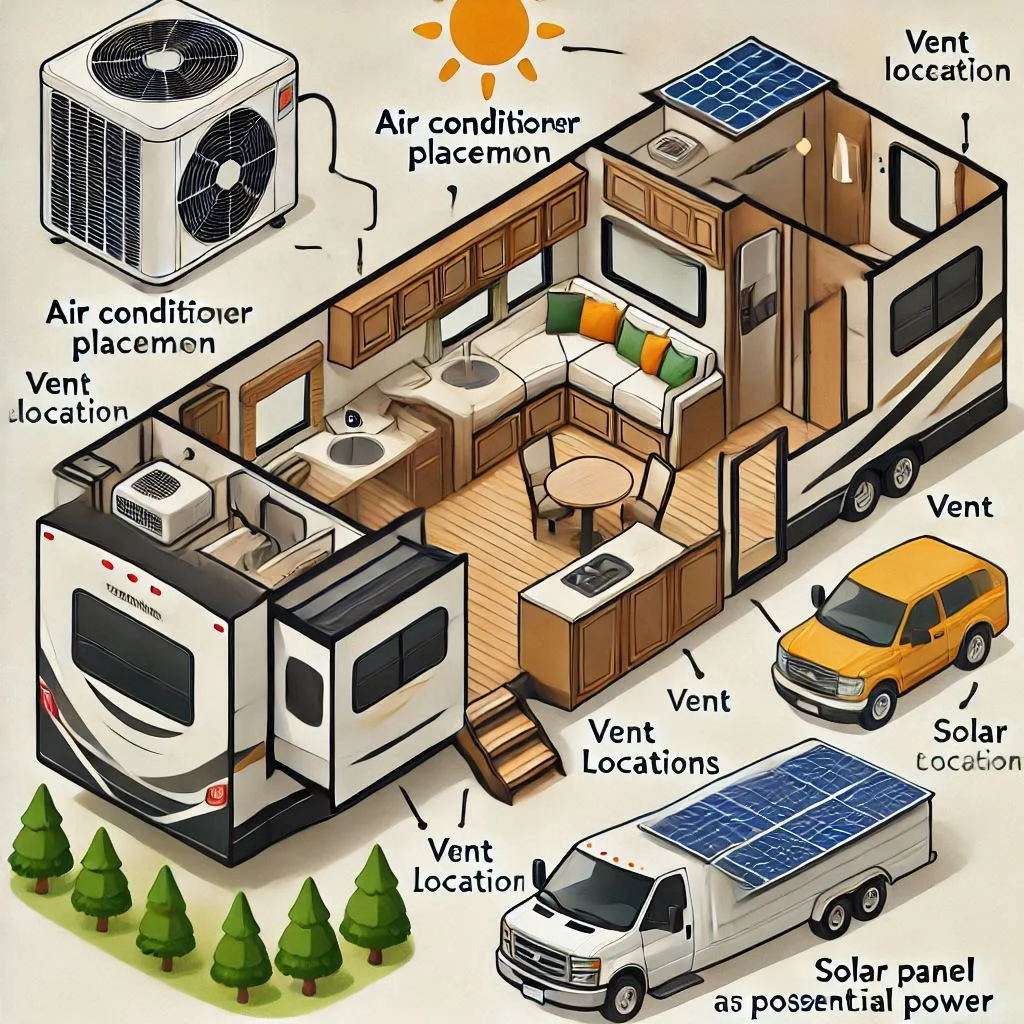
RV AC Wattage Based on Different Models
When selecting an RV air conditioner, it’s essential to understand how different models consume power. Each brand and model comes with its wattage specifications, depending on its size, cooling capacity, and design features. In this section, we will explore the wattage consumption of some of the most popular RV air conditioners, including the Atwood Air Command, Coleman-Mach 3 Power Saver, and other well-known units, providing you with the information necessary to choose the best AC for your RV and energy needs.
Atwood Air Command Wattage
The Atwood Air Command is a widely recognized RV air conditioner known for its high cooling efficiency and compact design. It typically comes in two main sizes—13,500 BTU and 15,000 BTU—which have different wattage requirements.
- A 13,500 BTU Atwood Air Command unit consumes approximately 1,500 to 1,800 watts when running and can require a 3,000 to 3,500-watt surge to start up.
- A 15,000 BTU Atwood Air Command unit uses around 1,800 to 2,100 watts during operation and requires a surge of 3,500 to 4,000 watts at startup.
The Atwood Air Command is designed for energy efficiency and quieter operation, making it a great choice for those who want an AC that doesn’t strain their power system.
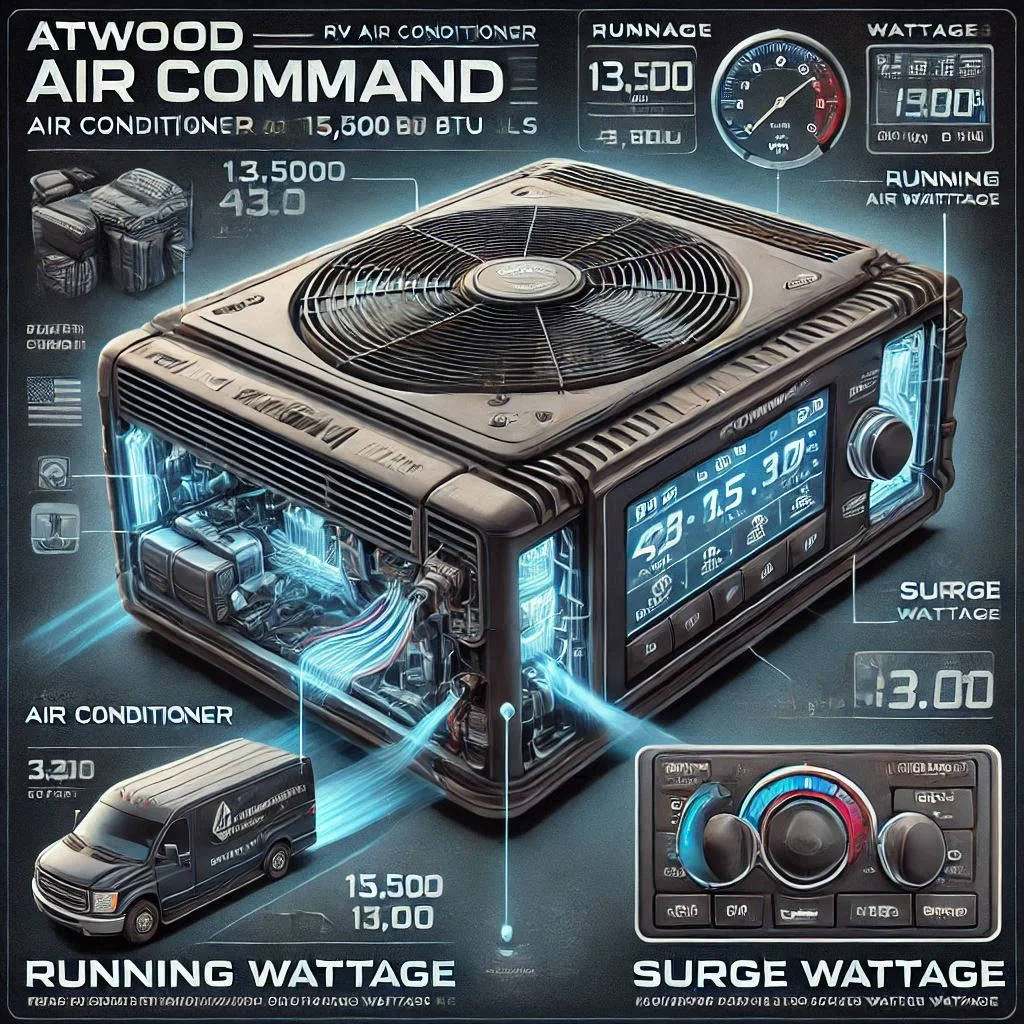
Coleman-Mach 3 Power Saver Wattage
The Coleman-Mach 3 Power Saver is another popular choice for RV owners. It is known for its energy-efficient design and quieter operation, making it ideal for smaller to medium-sized RVs. The Mach 3 Power Saver comes in 13,500 BTU and 15,000 BTU options, and its wattage usage is as follows:
- The 13,500 BTU Coleman-Mach 3 Power Saver uses approximately 1,350 to 1,500 watts when running, with a surge of 2,500 to 3,000 watts at startup.
- The 15,000 BTU Coleman-Mach 3 Power Saver consumes about 1,600 to 1,800 watts during continuous operation, with a startup surge of 3,000 to 3,500 watts.
This unit is popular among RVers due to its ability to save energy and operate efficiently while still providing excellent cooling power. The Mach 3 Power Saver helps reduce overall energy consumption, making it an excellent option for those who rely on generators or solar systems.
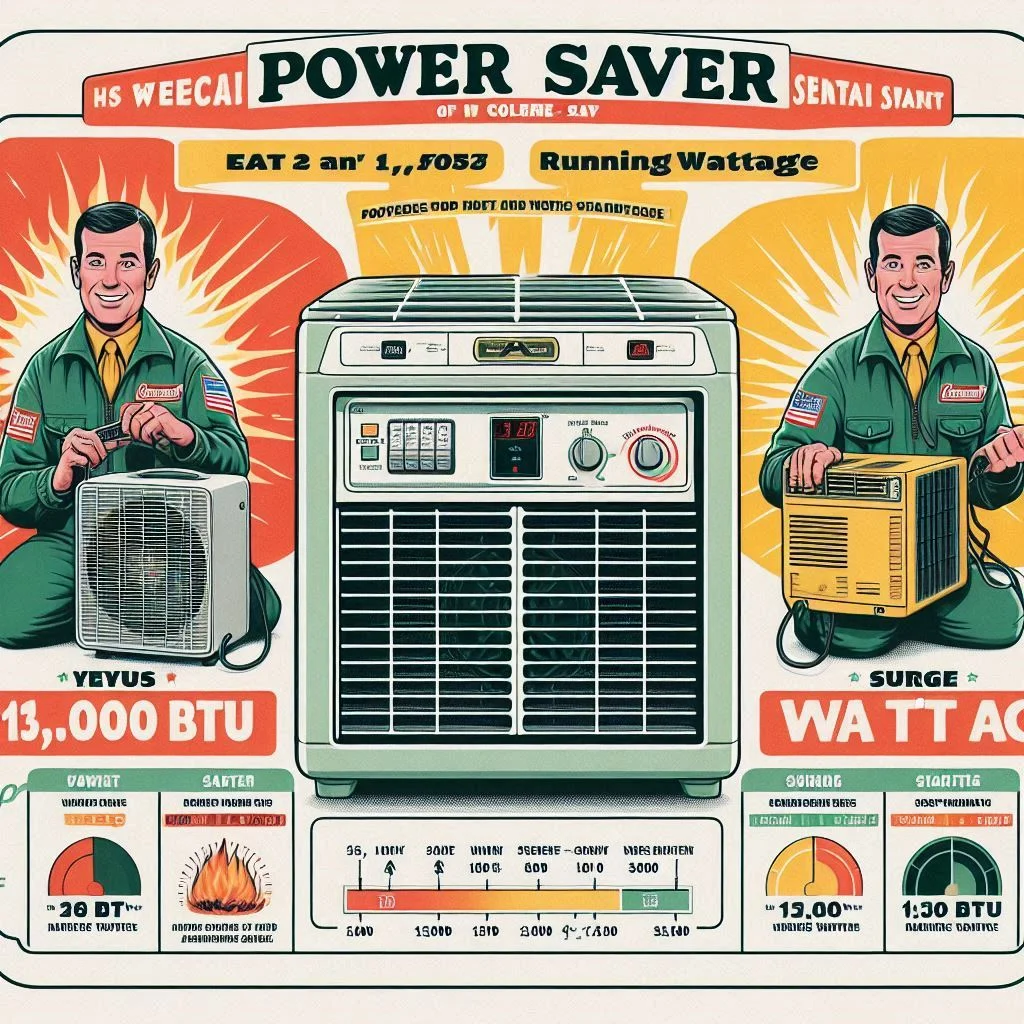
Wattage Comparison of Other Popular RV AC Models
There are various other RV air conditioners available on the market, each with its own wattage specifications. Comparing the wattage of popular models helps RV owners select the most energy-efficient option for their specific needs. Here’s a comparison of several other popular RV AC units:
- Dometic Brisk II (13,500 BTU): Consumes around 1,350 to 1,500 watts while running and requires a 2,500 to 3,000-watt surge.
- Furrion 15,500 BTU: Uses about 1,800 to 2,000 watts while running, with a surge of 3,500 to 4,000 watts at startup.
- Midea 8,000 BTU Portable AC: This unit uses 700 to 900 watts during operation, making it ideal for smaller RVs or as a supplementary cooling option.
When selecting an RV AC, it’s essential to consider your energy supply. Larger units with higher BTU ratings require more power to run, but they can also cool larger RVs more effectively. Smaller models like the Midea 8,000 BTU are suitable for compact RVs or temporary use in cooler climates.
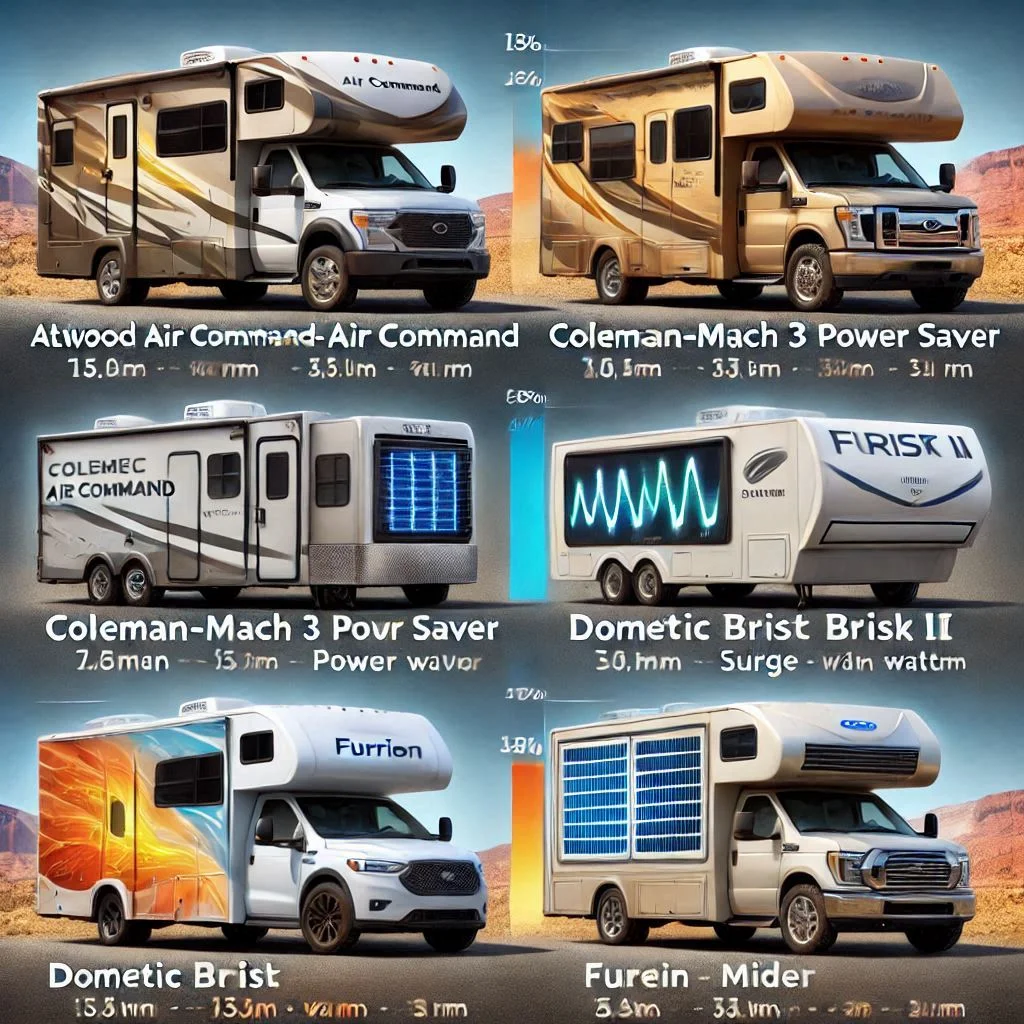
How Many Watts Does a Portable RV AC Use?
Portable RV air conditioners are an attractive option for many RVers due to their ease of use, flexibility, and ability to cool specific areas within the RV. Unlike built-in RV AC units, portable units can be placed wherever they are most needed, making them ideal for smaller RVs or temporary cooling solutions. However, understanding the wattage requirements of portable AC units is essential for RV owners, especially when it comes to power consumption and the ability to use off-grid power sources such as solar panels or generators.
In this section, we will dive into the wattage consumption of portable RV air conditioners, discuss the wattage range of these units, and compare their power needs with built-in AC units to give you a clearer idea of which option is best suited for your RV.
Wattage Range of Portable AC Units
Portable RV air conditioners come in a range of cooling capacities, usually measured in BTUs (British Thermal Units). The wattage consumption of these units depends on their size, cooling capacity, and design. Here’s an overview of the typical wattage range based on different BTU ratings:
- 8,000 to 10,000 BTU Portable AC: These smaller units generally consume between 800 and 1,200 watts during continuous operation. They are ideal for small RVs or for cooling a single room or compartment.
- 10,000 to 12,000 BTU Portable AC: These units typically use 1,200 to 1,500 watts while running. They are suitable for medium-sized RVs and provide sufficient cooling for one or two rooms.
- 12,000 to 14,000 BTU Portable AC: Larger portable AC units with this cooling capacity generally consume 1,500 to 1,800 watts. They are ideal for larger RVs or for cooling multiple rooms simultaneously.
It’s important to note that surge wattage, which is the power needed to start the unit, can be up to 2 to 3 times the running wattage. For example, a 10,000 BTU portable AC with a running wattage of 1,200 watts may require a surge wattage of 3,000 watts at startup. This surge must be considered when selecting a generator or power source.
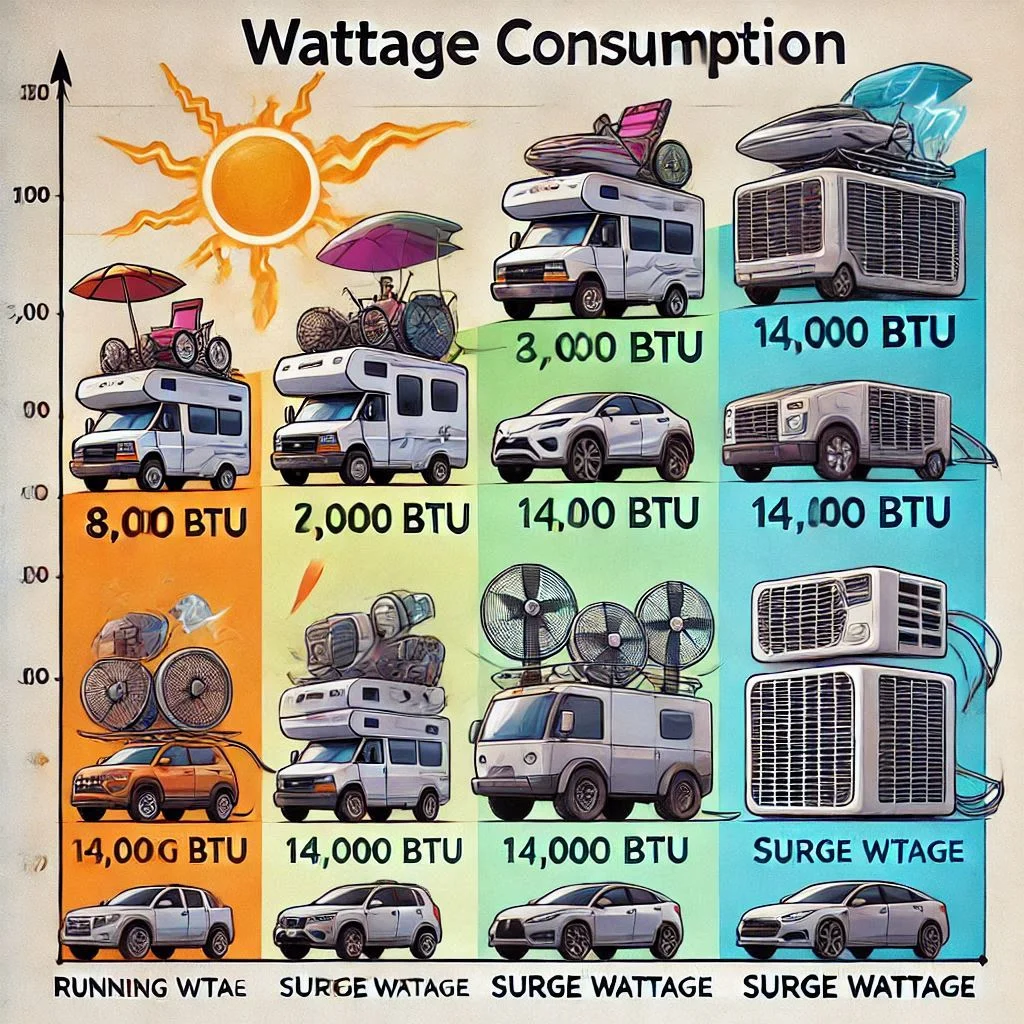
Comparing Wattage: Portable vs. Built-in RV AC Units
When comparing portable RV AC units with built-in (roof-mounted) RV air conditioners, there are several important differences in terms of wattage consumption. Although portable AC units offer flexibility and mobility, built-in units tend to be more efficient for cooling the entire RV.
- Built-in RV AC Units: Built-in air conditioners, such as the Atwood Air Command or Coleman-Mach 3, usually have higher wattage requirements due to their larger size and the fact that they are designed to cool the entire RV. For instance, a 13,500 BTU built-in unit typically consumes between 1,350 to 1,800 watts while running and requires a surge wattage of 2,500 to 3,500 watts at startup.
- Portable RV AC Units: As mentioned earlier, portable AC units consume between 800 and 1,800 watts, depending on their size. These units tend to have a lower wattage range compared to built-in units. However, they may not be as efficient in cooling the whole RV and are better suited for localized cooling.
The advantage of portable AC units is their flexibility and mobility, making them great for cooling specific areas or temporary solutions. They are also easier to install, as they only require an exhaust hose to vent hot air outside. Built-in units, on the other hand, are typically more power-efficient for cooling the entire RV but require more installation effort and might demand a larger power source.
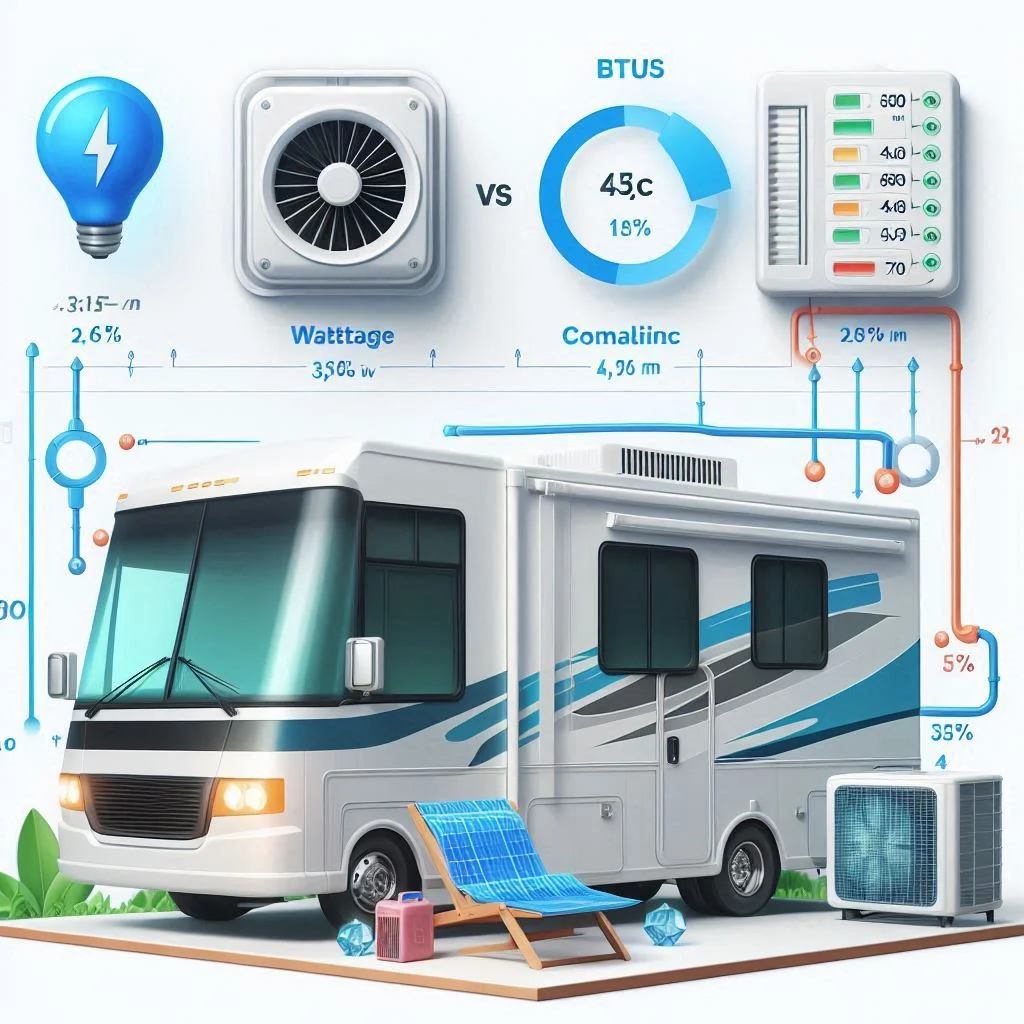
How to Make Your RV Air Conditioner More Energy Efficient?
Making your RV air conditioner (AC) more energy-efficient is essential for reducing power consumption, extending the life of the unit, and saving money on electricity costs. Whether you’re relying on a generator, solar power, or shore power, optimizing your AC’s energy use can help prevent overloading your power source while keeping your RV cool and comfortable. In this section, we will explore several key strategies to improve the energy efficiency of your RV air conditioner.
Keep the Filter Clean
One of the most straightforward and effective ways to enhance the energy efficiency of your RV air conditioner is to keep the filter clean. A clogged or dirty filter restricts airflow, forcing your AC to work harder and consume more energy. When the filter is clogged with dust, dirt, and debris, it reduces the amount of air that can pass through the system, causing the compressor and fan to overwork.
Benefits of Clean Filters:
- Improved Airflow: Cleaner filters allow air to flow more freely, making it easier for the air conditioner to cool the RV.
- Increased Efficiency: By reducing strain on the system, clean filters help your AC use less energy to achieve the desired cooling temperature.
- Prolonged AC Lifespan: Regular cleaning prevents damage to the internal components of the air conditioner, extending its life.
Tip: Make it a habit to check and clean the filter at least once every month or more frequently if you’re in a dusty environment. Replacing the filter every 3 to 6 months is also a good practice.
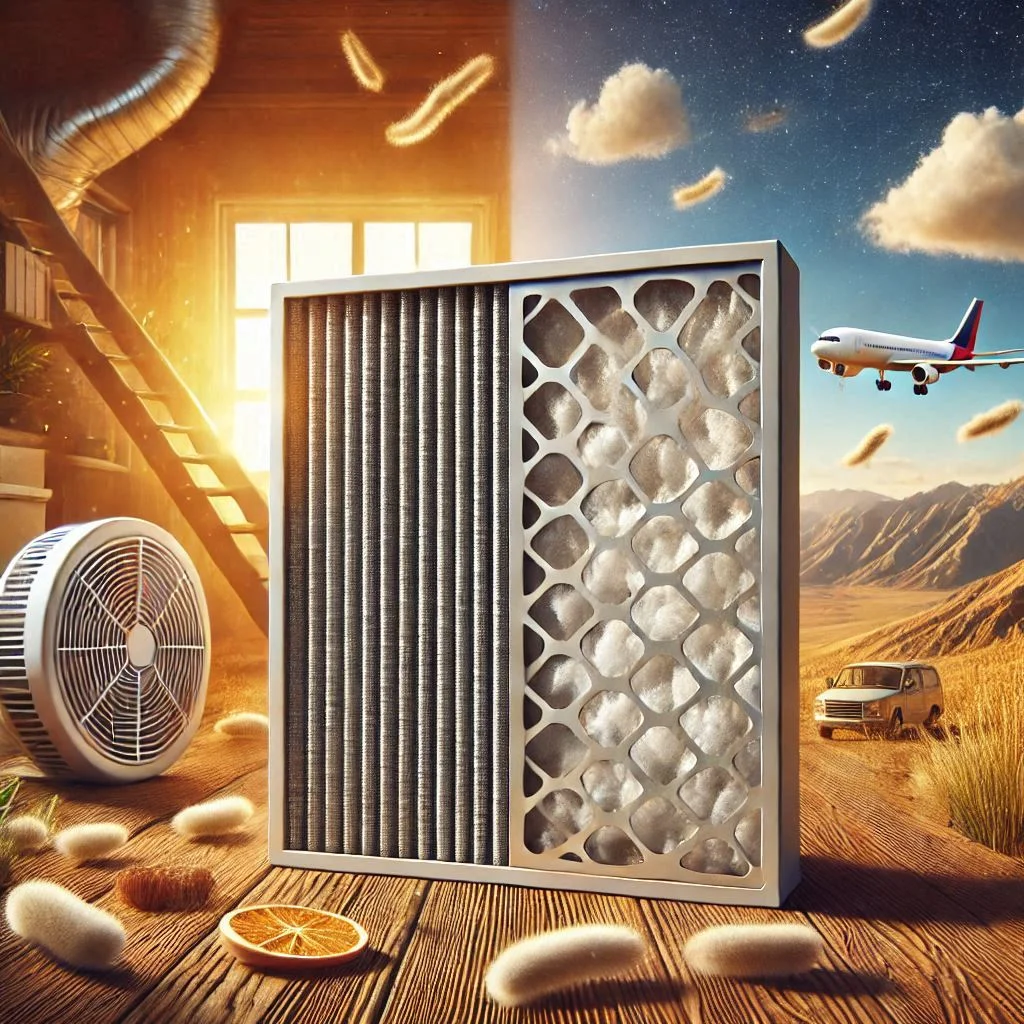
Insulate Windows and Doors
Insulating your RV’s windows and doors is another effective way to improve the efficiency of your air conditioner. Windows and doors are the primary areas where cool air escapes and heat enters, causing your air conditioner to work harder to maintain the desired temperature.
Benefits of Proper Insulation:
- Reduced Heat Transfer: Insulating windows and doors prevents outdoor heat from entering the RV and keeps cool air inside, reducing the workload on your air conditioner.
- Energy Savings: By limiting the amount of heat gain and loss, your AC will consume less energy to maintain a comfortable temperature inside.
- Improved Comfort: Proper insulation not only helps with cooling but also prevents drafts, making the RV interior more comfortable.
Insulation Methods:
- Reflective Window Covers: Use reflective materials or insulated window covers during the day to block out sunlight.
- Weather Stripping: Apply weather stripping around doors and windows to seal any gaps that might let cool air escape or warm air enter.
- Thermal Curtains: Invest in thermal or insulated curtains to keep the interior cooler.
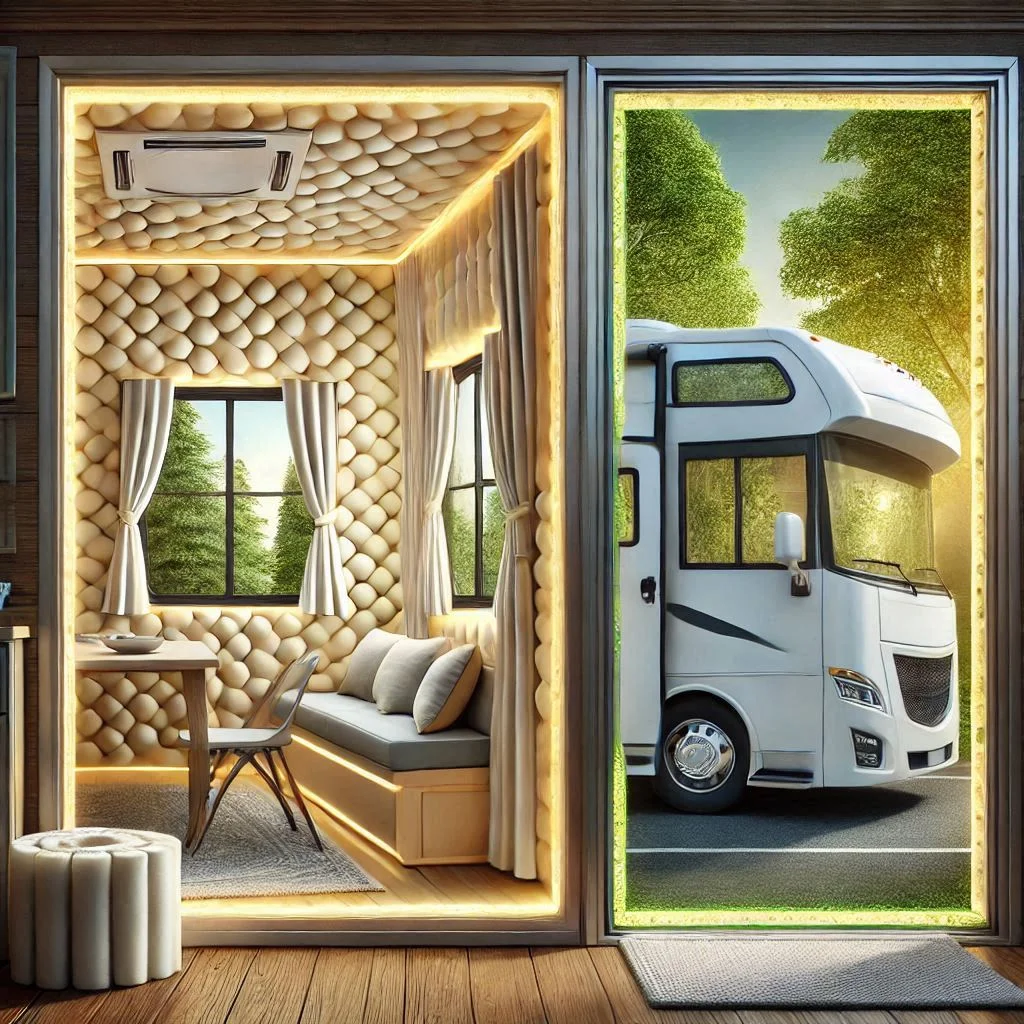
Optimize Thermostat Settings
Optimizing your RV air conditioner’s thermostat settings can have a significant impact on its energy consumption. Many RVers tend to set their AC thermostat too low, which results in excessive energy use. By adjusting the thermostat to more energy-efficient settings, you can maintain comfort while reducing power usage.
Tips for Optimizing Thermostat Settings:
- Set a Higher Temperature: Instead of setting the thermostat to 60-65°F (15-18°C), try setting it to 72-75°F (22-24°C). This range keeps the RV cool without overworking the air conditioner.
- Use a Programmable Thermostat: A programmable thermostat allows you to set the temperature to automatically adjust based on the time of day. This helps maintain comfort during the night and reduces energy consumption when you don’t need the AC running as hard.
- Avoid Frequent Temperature Adjustments: Constantly adjusting the thermostat can cause the AC to cycle on and off more frequently, using extra energy. Set it to a comfortable temperature and leave it there.
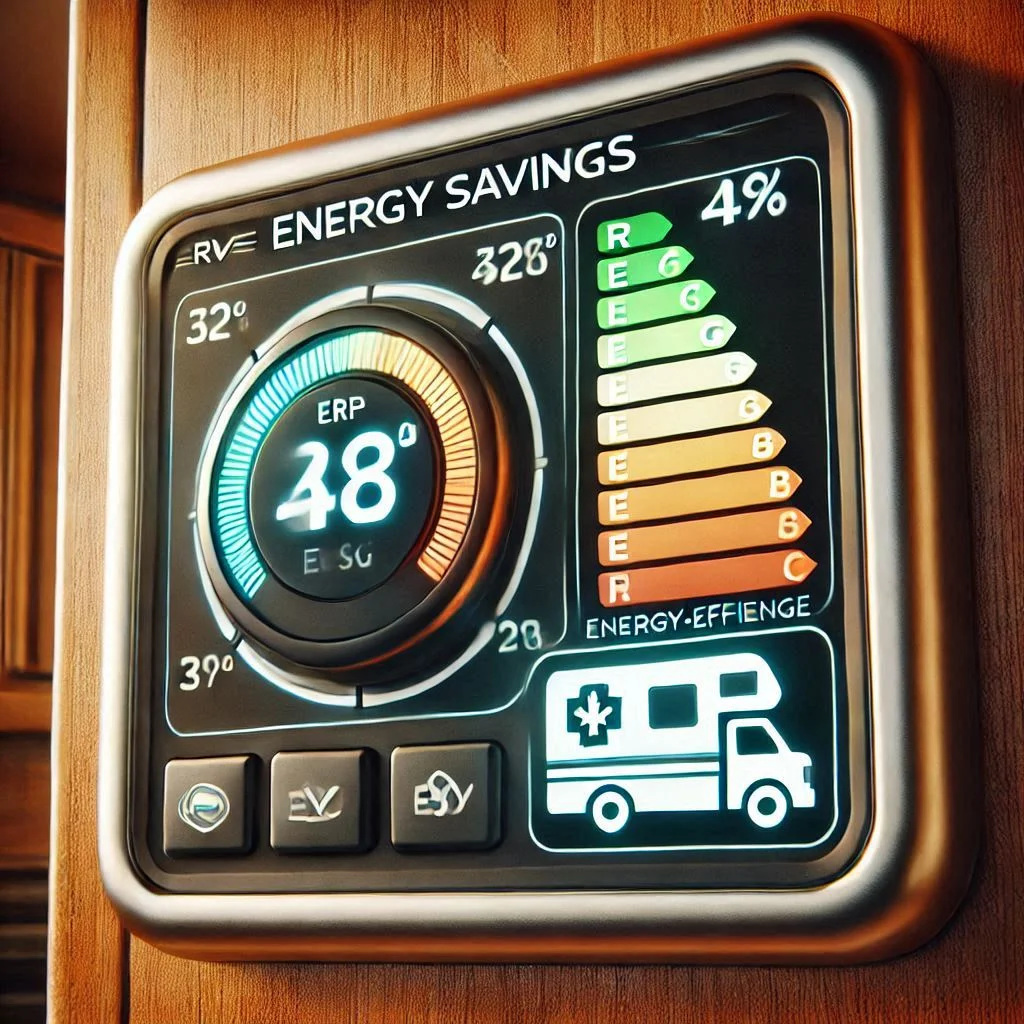
FAQ About RV Air Conditioner Wattage
When it comes to RV air conditioners, understanding their power consumption and how much electricity they use is essential for RV owners who want to optimize their energy use and avoid unexpected power shortages. This FAQ section will answer some of the most common questions about RV air conditioner wattage, helping you make informed decisions about your cooling needs.
1. What is the average RV air conditioner energy consumption?
The average energy consumption of an RV air conditioner varies based on several factors, including the cooling capacity (BTUs), the size of the RV, and the environmental conditions. However, on average, an RV air conditioner uses between 1,000 and 1,800 watts when running.
- Smaller Units (8,000-10,000 BTUs): These typically consume around 800-1,200 watts during normal operation. They are suitable for smaller RVs or cooling individual rooms.
- Medium Units (10,000-13,500 BTUs): These generally consume 1,200-1,500 watts, making them ideal for medium-sized RVs.
- Larger Units (14,000-15,000 BTUs): Larger RV air conditioners consume around 1,500-1,800 watts, which is necessary for cooling larger spaces or providing cooling to multiple rooms.
Tip: Keep in mind that the starting wattage (surge wattage) is usually 2 to 3 times higher than the running wattage, so make sure your power source can handle the initial surge when the AC kicks on.
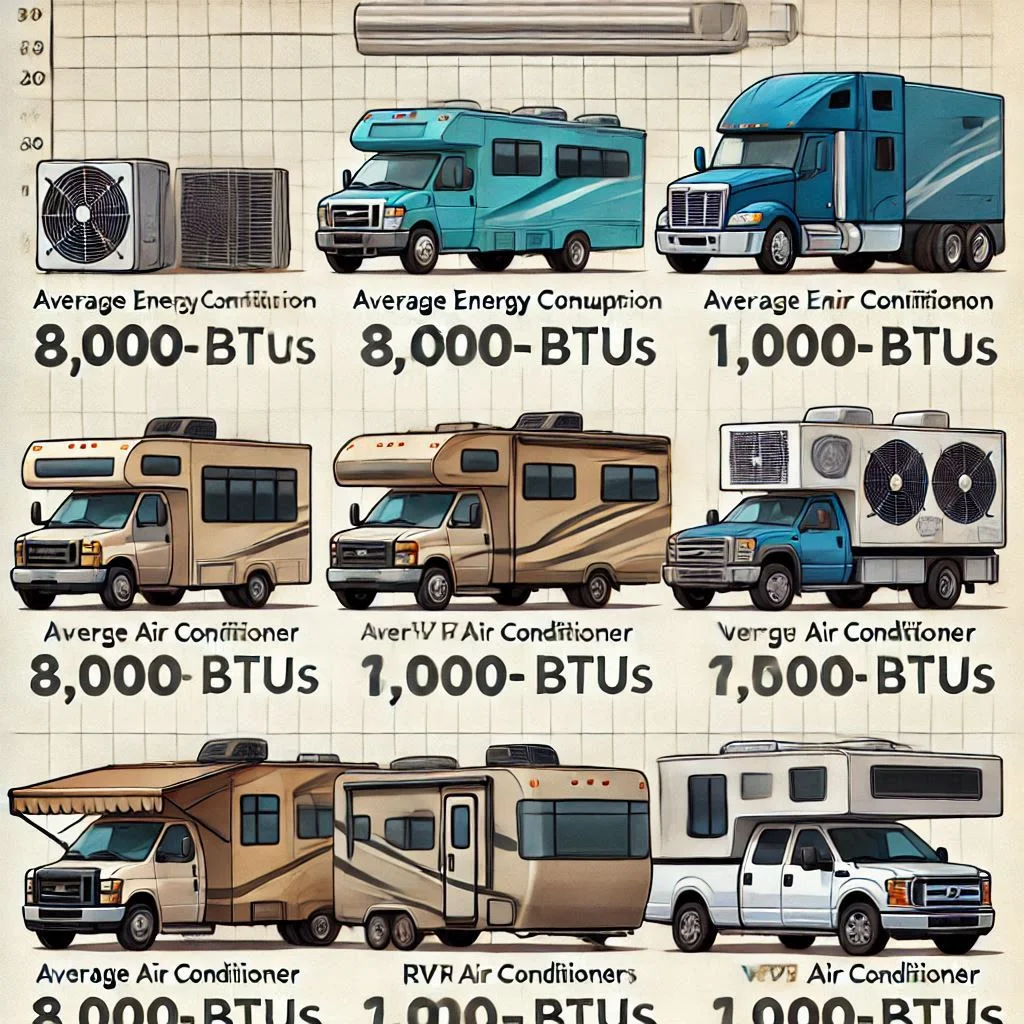
2. How much electricity does an RV air conditioner use per hour?
The amount of electricity an RV air conditioner uses per hour depends on its running wattage and the duration it operates. To calculate this, we can use the formula:
Electricity Usage (in kWh) = Wattage × Hours of Operation ÷ 1,000
For example:
- If a 13,500 BTU air conditioner uses 1,500 watts and runs for 3 hours, the electricity consumed would be: Electricity Usage=1,500 watts×3 hours÷1,000=4.5 kWh\text{Electricity Usage} = 1,500 \, \text{watts} \times 3 \, \text{hours} ÷ 1,000 = 4.5 \, \text{kWh}Electricity Usage=1,500watts×3hours÷1,000=4.5kWh
So, a 13,500 BTU air conditioner running for 3 hours would consume approximately 4.5 kWh.
Energy Tip: The total electricity usage will vary based on the air conditioner’s size, usage, and the outside temperature, so adjusting the thermostat and optimizing usage can significantly impact your overall consumption.
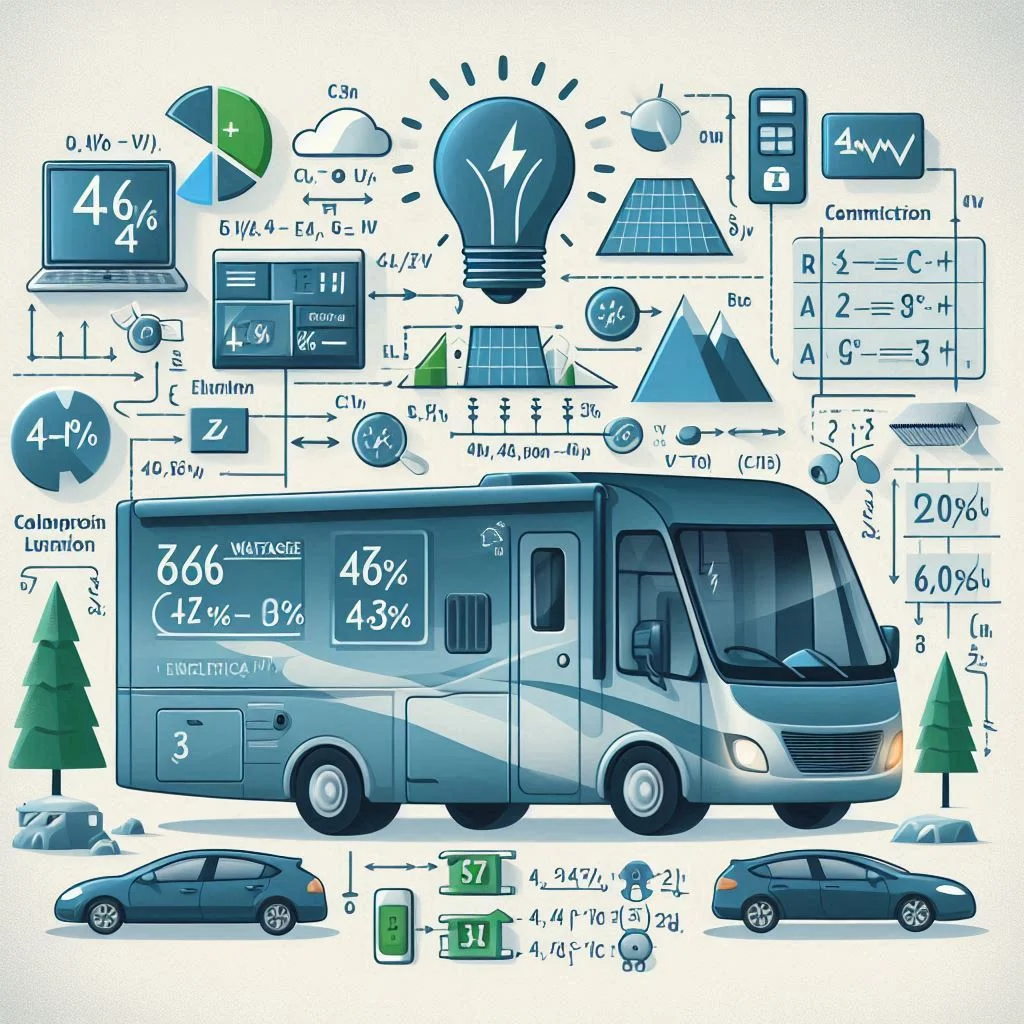
3. How many watts does a portable AC use?
Portable air conditioners for RVs have varying wattage consumption based on their size and cooling capacity (measured in BTUs). On average, portable RV air conditioners consume between 800 and 1,800 watts during operation. Here’s a breakdown of common wattage usage:
- 8,000 to 10,000 BTU portable AC: These typically consume between 800 and 1,200 watts.
- 10,000 to 12,000 BTU portable AC: These units usually consume between 1,200 and 1,500 watts.
- 12,000 to 14,000 BTU portable AC: These larger units can consume between 1,500 and 1,800 watts.
Surge wattage for portable units can be 2 to 3 times the normal running wattage. For example, a 10,000 BTU portable AC with a running wattage of 1,200 watts may require up to 3,600 watts at startup.
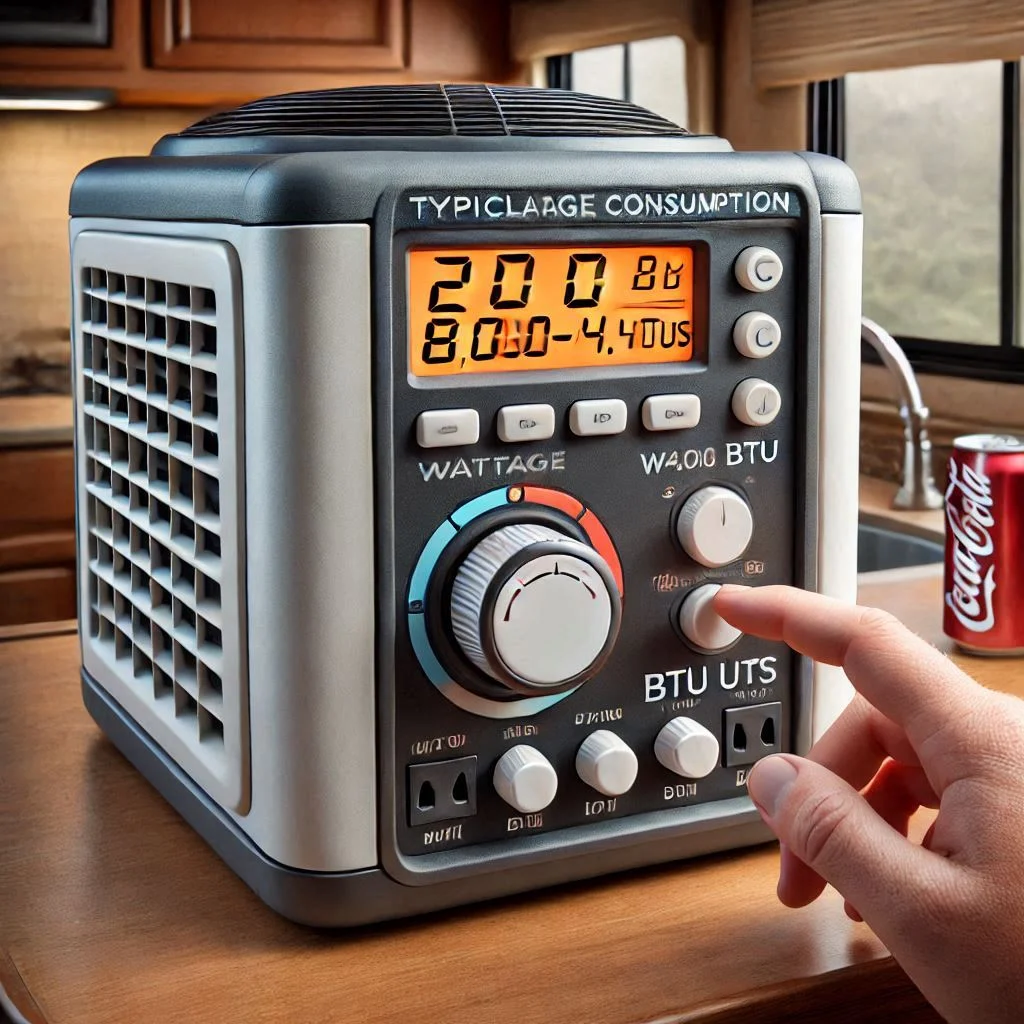
4. What size generator do I need to run my RV AC when off-grid?
When running an RV air conditioner off-grid, you’ll need a generator that can provide enough power to handle both the running wattage and the surge wattage required to start the AC. It’s essential to select a generator that can handle the initial power surge when the AC unit turns on.
- For 8,000-10,000 BTU Units: A generator with a 3,000-watt surge and 2,000-2,500 watts of continuous power should suffice.
- For 10,000-13,500 BTU Units: Choose a generator with at least 4,000 watts of surge power and 2,500-3,500 watts of continuous power.
- For 14,000-15,000 BTU Units: You will need a generator that provides 5,000-6,000 watts of surge power and 3,500-4,500 watts of continuous power.
It’s also a good idea to factor in other electrical appliances you may be using, such as lights, refrigerators, and microwaves, and ensure the generator has enough capacity to power them simultaneously.
Tip: Consider investing in an inverter generator for quieter operation and better fuel efficiency when running your RV AC off-grid.
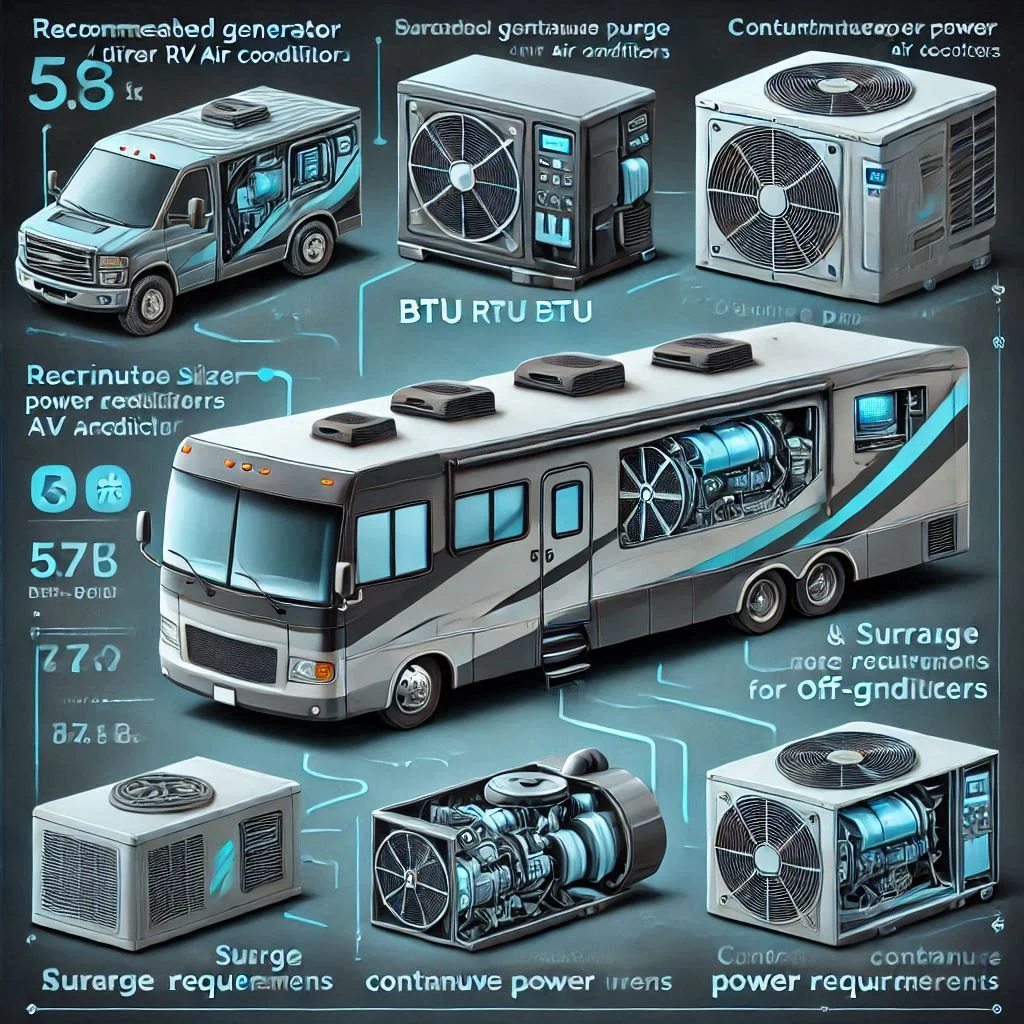
Conclusion
In conclusion, understanding the wattage consumption of your RV air conditioner is essential for effective energy management, especially when you’re off the grid. Whether you’re using a built-in RV AC, a portable unit, or relying on a generator to power your cooling system, knowing the energy requirements helps you make informed decisions about your RV’s power needs. By considering factors such as RV size, insulation, and ambient temperature, and optimizing your AC unit’s efficiency, you can minimize energy consumption while ensuring a comfortable travel experience. Remember, the right generator size and careful power management can ensure your AC operates smoothly and efficiently without overloading your electrical system. With the tips and insights shared in this blog, you’re now equipped to make smarter choices about your RV’s air conditioning and enjoy a cooler, more energy-efficient journey.

